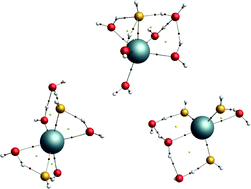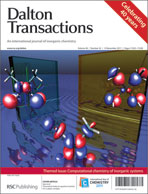The coordination of Sr2+ by hydroxide: a density functional theoretical study
Abstract
The molecular structures of gas-phase strontium hydroxide complexes are quantum chemically calculated using density functional theory, and the effects of hydroxyl groups on strontium coordination are studied. It is found that the presence of a single hydroxyl group results in the near-degeneracy of complexes with a coordination number (CN) of 5, 6 and 7. The presence of a second hydroxyl group destabilises the heptacoordinated complexes, and marks the onset of a weakening of the Sr–OH2O bonds, as evidenced by analysis via the quantum theory of atoms in molecules (QTAIM) and measurements of the average angle between the Sr–OH2O bond and the H2O dipole moment. A third hydroxyl group strongly destabilises both CN = 6 and 7 complexes through significant weakening of the Sr–OH2O interaction; here, hydrogen bonding interactions between hydroxyl groups and

- This article is part of the themed collection: Computational chemistry of inorganic systems

 Please wait while we load your content...
Please wait while we load your content...